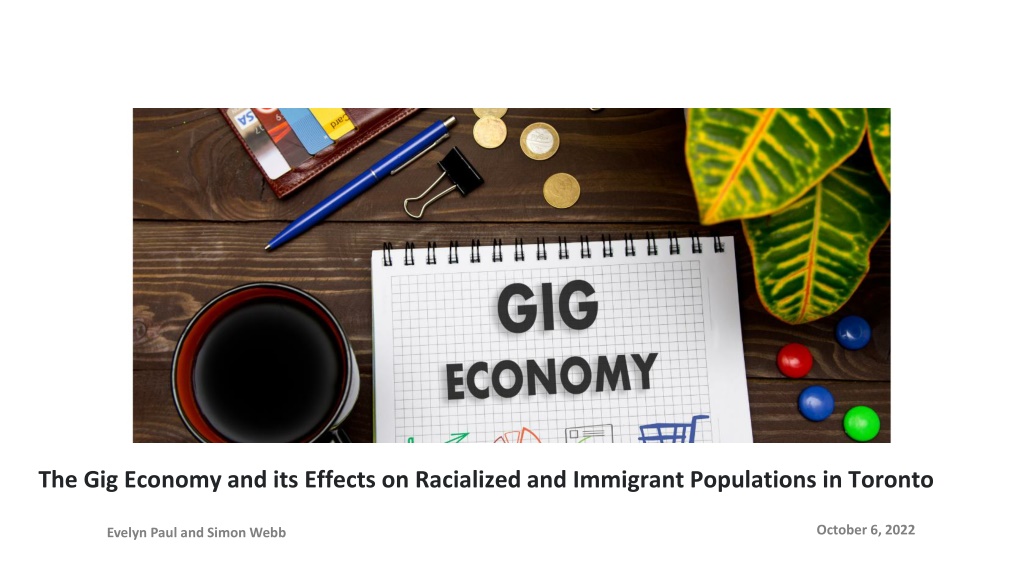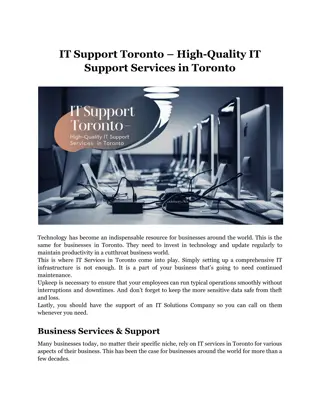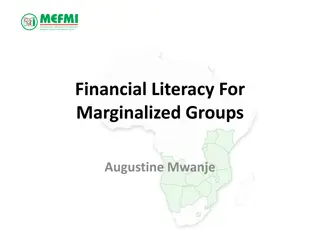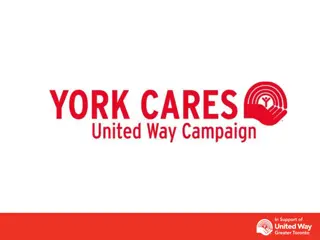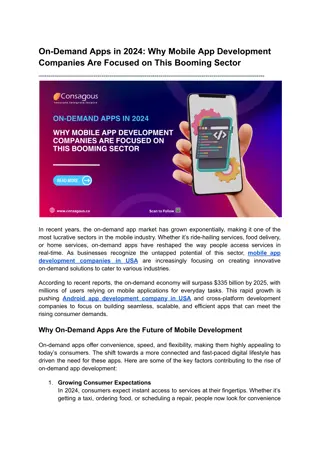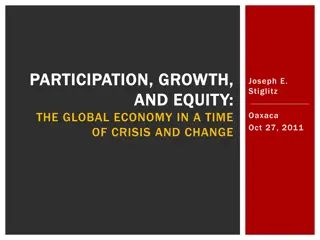Understanding the Impact of the Gig Economy on Marginalized Groups in Toronto
This report delves into the effects of the gig economy on racialized and immigrant populations in Toronto. It outlines research findings, stakeholder insights, and strategic recommendations to address the challenges faced by marginalized groups in the gig economy. The study aims to shed light on the size, structure, and impact of gig work, particularly on women, racialized Canadians, youth, newcomers, immigrants, seniors, Indigenous Peoples, and low-income earners. Through a detailed project overview, the report highlights the importance of understanding the long-term effects of gig work and offers directions for measuring the gig economy in Canada.
Download Presentation

Please find below an Image/Link to download the presentation.
The content on the website is provided AS IS for your information and personal use only. It may not be sold, licensed, or shared on other websites without obtaining consent from the author. Download presentation by click this link. If you encounter any issues during the download, it is possible that the publisher has removed the file from their server.
E N D
Presentation Transcript
The Gig Economy and its Effects on Racialized and Immigrant Populations in Toronto October 6, 2022 Evelyn Paul and Simon Webb
The Gig Economy Forum Report Presentation Agenda Project Overview Background Research Stakeholder Interview Insights Survey Findings: Who s included in Toronto s Gig Economy? Strategic Directions and Recommendations This Photo by Unknown Author is licensed under CC BY-SA-NC 2
Project Overview Rationale, Key Objectives, Timeline, Research Process 3
The Gig Economy Forum Report Presentation Rationale Important part of the labour market but cannot accurately measure Continued speculation on the number of gig workers Largely unknown effects on participation for marginalized and racialized groups Impact of COVID-19 on the economy needs to be understood Gig work and the issues surrounding the economy are particularly relevant for Toronto This Photo by Unknown Author is licensed under CC BY-NC-ND 4
The Gig Economy Forum Report Presentation Key Objectives Gather information on the size and structure of the gig economy in Toronto Lay a foundation of what the gig economy looks like in Toronto Identify if and which groups (women, racialized Canadians, youth, newcomers, immigrants, seniors, Indigenous Peoples, and low-income earners) are disproportionately impacted Understand the long-term effects of gig work in an unregulated environment Inform future directions on measuring the gig economy in Canada 5
The Gig Economy Forum Report Presentation Project Timeline Phase 2 Phase 1 Phase 3 Engagement Readiness and Implementation Project Initiation Reporting & Recommendations (August - October 2021) (March 2022) (October 2021 January 2022) 6
The Gig Economy Forum Report Presentation Research Process Phase 1 Environmental Scan/Literature Review Interviews with Gig Employers and Organizations Jurisdictional Review and Summary Report Phase 2A Stakeholder Interviews Interviews with Knowledge Holders & Gig Experts Interviews with Gig Economy workers Pre-panel Stakeholder Interviews Post-panel Stakeholder Interviews Phase 2B Panel Survey of gig workers Survey Findings Interim Report Discussions with ICE Advisory Team Gig workers Survey The Project included Phase 3 Reporting & Recommendations Draft Report and Presentation Final Report 7
Background Research Environmental Scan/Literature Review, Jurisdictional Review, Planning Context 8
The Gig Economy Forum Report Presentation Components of the Gig Economy Includes independent contractors, consultants and freelancers; temp agency workers and on-call workers; contract company workers Consumers who need a specific service Independent workers paid by the gig Characterized by short-term, temporary, often unpredictable, lacks formal arrangements COVID-19 increased the supply and demand for gig workers Companies who connect workers directly to consumers Momentum towards recognizing gig workers as dependant contractors 9
The Gig Economy Forum Report Presentation Jurisdictional Review California, USA: Prop 22 reclassifying gig workers as contractors with benefits New York, USA: passed six bills to set minimum pay and improve working conditions for independent contractors United Kingdom: introduced a worker classification with benefits and protections Australia: unified national definition of the gig economy and benefits for gig workers Ontario: Provincial legislation proposed that would give a $15 minimum wage to app-based gig workers (pending) 10
Stakeholder Interview Insights Discussions with gig workers, employers and knowledge holders 11
The Gig Economy Forum Report Presentation Stakeholder interview responses Advantages working in the gig economy Disadvantages working in the gig economy Impact on/for marginalized populations Flexible hours of work, work schedule, fees/payments and work location Lack of job security, stability and benefits On-the-job discrimination/harassment Lack of consistency both in terms of work and the type of jobs available Hiring discrimination Time left for other priorities Over-represented in lower wage/lower benefit jobs Short-term projects Sometimes workers are competing for a limited number of contracts This population is often forced to take lower earning jobs more often and left without benefits Workers don t lose their creative spark or experience monotony of full-time, routine work Lack of established workers rights, focus is on saving labour costs 12
The Gig Economy Forum Report Presentation Stakeholder interview responses continued Benefits needed for gig workers Role of Technology Impact of COVID-19 Medical insurance (health, dental, vision), retirement, life insurance, paid time-off Supports the growth of the economy Increased lay-offs, retirement Easy access to gig workers, products and services Participation in the economy has increased Associations, networking opportunities, student support, gig events, mentorship Essential to grow customer database and source network and suppliers Home-delivery for necessities increased Insurance packages could be included as part of contract Digital knowledge essential to grow customer base Dedicated staff at City 13
The Gig Economy Forum Report Presentation We tested the following gig economy definition through interviews. The GIG economy is generally described as people working as Freelancers, Consultants, Independent Contractors and Professionals and temporary contract workers. Working in the GIG economy can be a primary source of income or could also be in addition to other work as supplementary income. Some examples of GIG economy work could include, Artists, online handyman services, driving for Uber or LYFT, delivering food, writing programming code or freelance articles as well as part-time teaching. and received the following responses: Generally, agree with definition Characterized by part-time, often multiple jobs by one person Precarious; both in terms of wages and job security Freelance is an important, growth sub-sector of this economy Definition needs to consider dependent contractors; those selling to only one company/employer Include flexible Needs to reflect the economy is more low earning self-employment 14
Whos included in Torontos Gig Economy? Panel Survey Insights 15
The Gig Economy Forum Report Presentation Gig Economy Panel Survey Key Takeaways Wide-ranging types of work and work arrangements Gig work spanned many different work arrangements, and hours. Workers often provided services to several companies. Food delivery, home-based computer work, office work and data entry were some of the most common occupations. High levels of moderate satisfaction 55% of gig workers were somewhat satisfied working in the Gig Economy, 36% were very satisfied. Key Benefits of work in the Gig Economy - The four factors with the highest amount of satisfaction among respondents were: ability to control amount of work, work/life balance, flexibility of schedule, and flexibility of work arrangements. Key challenges and priorities in the gig economy Top four priorities: access to sick pay, job security, access to health insurance, and career growth opportunities. Evidence of Discrimination in the Gig Economy - 14% of the marginalized populations in the survey reported issues related to discrimination that they had experienced in the Gig Economy. 16
The Gig Economy Forum Report Presentation Reasons for Entering Gig Economy To what extent was each of the following statements a factor in your decision to participate in the Gig Economy? (n=163) I wanted extra income in addition to other employment 49% 26% 31% 30% I wanted to gain experience to build my career 26% 21% I was laid off due to COVID 24% 23% I wanted to work while I travel Start building my own clientele (Ex. Computer programmers etc.) 23% 34% 17% 37% I couldn t find work that accommodates my needed schedule 17% 39% The gig economy was the only option to complete the work 13% 26% I am currently in training/education 12% 24% My education/training/degree is not recognized in Canada A significant factor Somewhat of a factor Not a factor at all/Does not apply to me 17
The Gig Economy Forum Report Presentation Gauging the Policy Priorities for Gig Workers - Priority Matrix The Priority Matrix consists of three metrics: Level of Importance: A statistical measure of the strength of relationship between the factor, and overall satisfaction. Performance: The percentage of gig workers somewhat or very satisfied with this attribute of the gig economy. Priority rank: Determined for each factor based high levels of importance and low levels of performance. 18
The Gig Economy Forum Report Presentation Proposed Project Definition of the Gig Economy The gig economy is an integral part of the economic system. It represents the self-employed and non-standard workforce providing payment-by-task services to consumers through digital platforms and gig companies. While the self-employed gig worker provides services directly to the consumer, the non-standard gig worker enters into formal agreements with gig companies to provide services to the company s clients. Key characteristics of the gig economy include: Part-time, temporary, short-term and flexible working arrangements Work is often precarious as it relates to job security, benefits, and income Segmented economy high income/advantaged groups vs. low income/multiple jobs by one person/disadvantaged groups Include freelancers, consultants, dependent and independent contractors, professionals, and technical service personnel. Examples include ride-hailing and delivery, creatives (artists, writers etc.), temp-agency workers, handyman services, programming, coding, and part-time teaching 20
The Gig Economy Forum Report Presentation Strategic Direction 1: Adopt a standard definition to describe Toronto s gig economy Building from the standard definition, regularly examine the alignment of the definition. Consult with gig worker communities, companies, researchers, and policymakers to promote a standard gig economy definition for Toronto and the province. Continue to foster a knowledge-sharing environment within the various government entities. Launch a marketing campaign, that clearly describe the gig economy s various components and clarify misconceptions about this economy. 21
The Gig Economy Forum Report Presentation Strategic Direction 2: Focus workforce development efforts to support gig worker priorities Engage with gig worker communities to build a continual understanding of their needs, support skills development, training, and networking opportunities. Foster partnerships with Workforce Planning Ontario to further labour force research and resources. Enable access and promote co-working spaces in the city as key community spaces for gig workers to meet, network and engage with clients. Position a gig economy working group consisting of decision-makers and key stakeholders. 22
The Gig Economy Forum Report Presentation Strategic Direction 3: Focus research to continually inform and measure the economy Engage with researchers to further understand which groups within the gig economy, including women, racialized Canadians, youth, newcomers, immigrants, seniors, Indigenous Peoples, and low-income earners, are disproportionately impacted. Investigate and promote best/better practices to influence policies and further position the City of Toronto as a key enabler of a fairer gig economy. Labour market information to understand and examine the skills levels and occupations in the gig economy. Undertake research to understand the long-term impact of COVID-19 on the gig economy. Continually engage with gig employers and sectors within the economy to understand their needs and undertake a sector-based approach to research and policy development. 23
The Gig Economy Forum Report Presentation Strategic Direction 4: Continue to track policy progress in the economy Consider adopting the 2021 Ontario Workforce Recovery Advisory Committee (OWRAC) report and recommendations. Continue to track Ontario s proposed legislation that would give a $15 minimum wage to app- based gig workers to examine applicability and impact on the gig workers and the economy. Continue to track progress on the provincial portable benefits system, designed to benefit workers who do not have health, dental or vision coverage. Monitor implementation of the 2020 Rebuilding Toronto s Gig Economy Policy Brief recommendations. Promote the federal Canada Performing Arts Workers Resilience Fund (CPAWRF) for independent and self-employed workers in the live performance sector. Research action and outcomes resulting from the 2015 Toronto Poverty Reduction Strategy. 24
THANK YOU! Evelyn Paul, Manager, Deloitte evpaul@deloitte.ca Simon Webb, Senior Associate, Deloitte swebb@deloitte.ca 25
